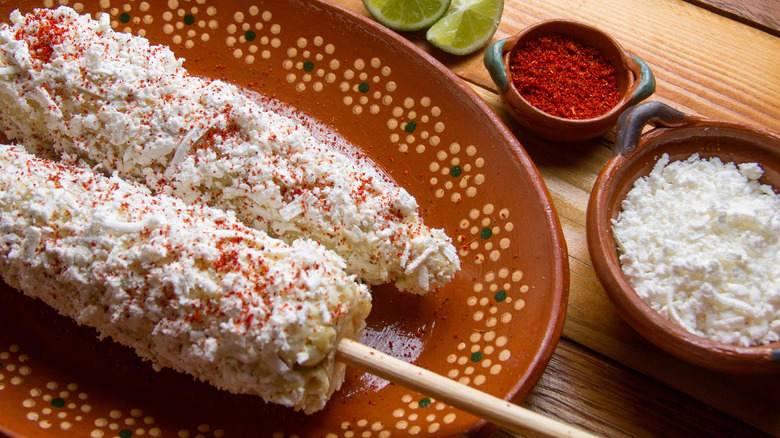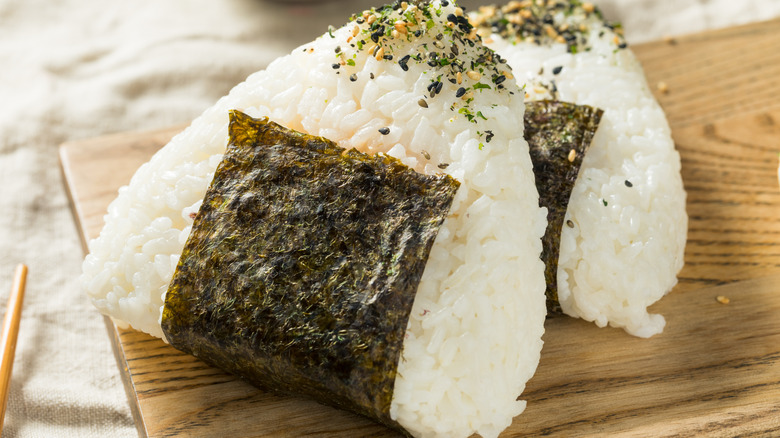The Secret Ingredient That Adds New Life To Elotes
A Mexican-style elote is inarguably delicious. This dish features grilled or boiled corn on the cob — or cut-off kernels that are scooped into a cup — that are then topped with only good things like lots of mayonnaise, briny cotija cheese, bright cilantro, zippy lime juice, and spicy chili powder. This simple Mexican street food also lends itself to plenty of variations. As such, elotes create a perfect base for a seasoning originating from the other side of the world — furikake.
At its most basic, this Japanese condiment combines nori seaweed, sesame seeds, dried fish, salt, and sugar. It can also include many other savory ingredients like mushroom powder, yuzu zest, wasabi, miso powder, shiso leaf, salmon flakes, eggs, dried shrimp, monosodium glutamate, and other types of seaweed like wakame and kombu.
Furikake, which means "to sprinkle," was created as a mineral-rich seasoning for rice. It's often used as a topper for vegetables, porridges, eggs, ramen, creamy noodle dishes, and onigiri rice balls, and lends itself to the mild base flavors of an elote. The sesame seeds pair with the nutty and starchy corn, and the seaweed and dried fish give a salty, umami hit that the sweet, creamy mayo and tangy cheese can benefit from.
Japanese ingredients for perfect furikake elotes
A traditional Mexican-style elote sprinkled with furikake is a totally delectable fusion. However, there are some Japanese ingredient substitutions you could also make to lean into the pairing. For example, rather than using McCormick mayonesa with lime juice that is common across Mexico, opt for Kewpie mayo. The latter is a Japanese brand that uses only egg yolks and is slightly sweeter than most mayonnaise products. The company even has a smoked variety that would pair well with the char of grilled corn.
You could also substitute the chili powder for shichimi togarashi, a spicy chili pepper blend that has some overlapping ingredients with furikake like sesame seeds and seaweed, but can also contain citrus zest, garlic, and poppy seeds. If you want pure chili powder, opt for togarashi instead. Another idea would be to add thin ribbons of citrusy shiso leaves in addition to or instead of the cilantro.
Melty and soft cheeses are more popular than crumbly cheeses in Japan, so there isn't an obvious substitute for the cotija cheese. In a Mexican elote, the cotija adds salt and texture, but furikake can serve that same role. Finally, sprinkle your elote liberally with the furikake. It has a well-balanced sweet and salty flavor, so you can be fairly heavy-handed. No matter what, finish with a squeeze of fresh lime juice for an acidic balance to the fat and sugar in the toppings.
Furikake elotes go great with rice
You can definitely enjoy an elote with furikake seasoning on the cob just as is, but you can also cut the kernels off, mix the corn with all the ingredients, and serve it on top of a Japanese staple — rice. A rice bowl topped with a mayo-laden salad featuring canned tuna, salmon, or boiled egg is a common meal in Japan, and elotes are pretty much a mayo-based, Mexican street corn salad.
You can also use your furikake elotes as a filling for onigiri — a convenience store mainstay or quick homemade snack. These rice balls can have any number of fillings like fish, roe, pickled vegetables, and mayo salads. They are typically wrapped in seaweed and served cold, but for yaki onigiri, the rice ball is grilled or pan-fried until golden brown and crispy, and then glazed with a soy or miso sauce.
Whatever the vehicle, creamy, sweet, and spicy elotes pair perfectly with soft and chewy steamed rice. Plus, by design, furikake and rice are a perfect match.



